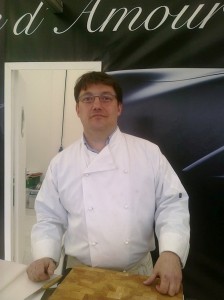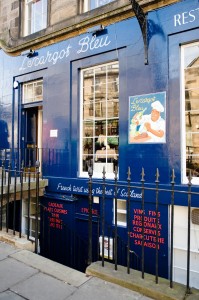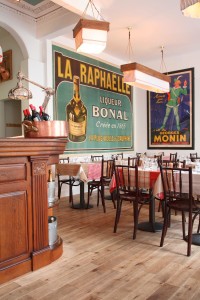 ][1]
][1]Along with Betty Jourjon, Fred Berkmiller runs L’Escargot Blanc, L’Escargot Bleu and l’Escargot Bleu épicerie in Edinburgh.
The two restaurants specialise in classic French dishes made with very carefully sourced Scottish produce. L’Escargot Bleu opened early 2009 and Blanc followed soon after. At the moment, L’Escargot Blanc is running a 5pm offer where £20 buys a three course surprise dinner and, if there are four or more of you, a free bottle of wine.
In this Chewing the Fat interview, Fred tells 5pm about the roots of French cooking, his appreciation of Scottish producers and why snails are best eaten without their shells.
When did you first come to Scotland?
FB) I came to Scotland in 1995. I had met Betty in London. She was working for Pierre Victoire at the time and I was working for another French caterer. I started working with Pierre and then we moved up here and worked with the Pierre Victoire franchises until it all collapsed in 1998. We opened Petit Paris in Edinburgh’s Grassmarket in late 1998.
What was the difference between Petit Paris and the PV operations?
FB) At Petit Paris, we went back to our roots. If Pierre had perhaps adapted dishes to the Scottish palate, we kept it classic. We got rid of the ginger and spring onions and went back to red wine and shallots. It was Boeuf Bourguignon, Toulouse sausages, old classics. You can’t beat them. It was done properly and priced properly. Of course, the Grassmarket location helped. But, if there was a secret to the success of Petit Paris, it was simple: there was a demand for classical French bistro food.
The popularity of different cuisines waxes and wanes but French food seems to have an enduring appeal in Britain. Any thoughts why?
FB) French food covers a very wide spectrum. There are many classic French dishes. There is nothing new in there but if you look at, say, an old pot au feu, its roots go back 150 or 200 years. I think those deep roots help account for French food’s popularity. The classic dishes are time-tested.
 ][5]
][5]How does a country’s food move forward if you never change anything?
FB) French food does hit obstacles. Young chefs don’t necessarily want to carry on cooking the classics. They believe they have to be creative and new and follow fashion. I don’t agree. I think you become creative once you know your roots. Once you know the classics then you can do anything you want. I have an issue with chefs who can make a beetroot sorbet but can’t make a decent Boeuf Bourguignon. It takes time to do a Boeuf Bourguignon properly.
Here, we take time with our cooking. We don’t do it in half an hour. A Boeuf Bourguignon could start being prepared in here on Monday and be served the following Monday. That’s slow food. I’m trying to do the things that my mother and her mother used to do.
Did you train as a chef in France?
FB) Yes. I was no good at school and was kicked out early. I was sent to a kitchen in Sainte-Maure de Touraine. It was a routiers (truckers) restaurant and it was hard. Me and the other trainee had to cook for the owner’s family and then sit in silence while they ate. I tried to get the sack but the boss kept me on.
I was thirteen and a half when I did my first summer with him. It was week on, week off. My Mum would drop me off on a Monday and collect me on the Sunday morning. I tried everything to get the owner to get rid of me but he didn’t. I even trod on my own glasses. I called my Mum thinking that that was me going home. Not so fast, Fred. Three hours later, she turns up with another pair of glasses saying, ‘I’ll see you on Sunday! Cheerio!’
It doesn’t sound like a great introduction to life in the kitchen?
FB) To be honest, the boss was a b*****d but if I had the chance to go back now I would thank him because he did teach me about food. He would be growing veg in his garden; conserving fruit over the winter; salting his own hams. You don’t see that anymore. On the first rainy day, we would head out in his van collecting snails.
Back then we were still allowed to prep poultry or rabbits straight from the farm. Me and the other trainee would spend hours in the cellar plucking and gutting the animals that the restaurant owner had brought back from his mate’s farm. It’s completely banned now and I think that’s wrong. We have a generation who don’t know what a chicken should look like. They go feed a duck in a park but can’t make a connection between that and a duck on a plate.
When did you move to London?
FB) It was the end of 1988. I was in L’Escargot Dorée for a while; Mon Plaisir, Cassis restaurant. I tried to work with Pierre Koffman but he never took me on. I’m very envious of Tom Kitchin down in Leith. Each time I tried to work with him, Koffman told me that I had started working at fourteen so I already had my own ideas about cooking and I should carry on with them.
At the time, I really wanted to work with him. He was doing the food that I like. Things like cassoulet, nothing fancy but done incredibly well. He could spend hours stirring a sauce and reducing it until it was just right.
What prompted you to start the escargots restaurants?
FB) I sold my part of Petit Paris to my business partner there. It was time to move on. With L’Escargot Bleu, I wanted to recreate a link between me as a chef and the food produced in Scotland. That was something I had ignored. Petit Paris was about creating French dishes using French food: boudin noir or Toulouse sausages.
I started to do a bit of work with Slow Food and the Farmers’ Markets and I quickly realised that there are fantastic Scottish products out there. The Scottish producers are so willing to pass on the knowledge that they have of their product and they are keen to supply what I need. They have so much passion. It means you have a closer connection with your producers.
Take someone like Roger at Gartmorn Farm: he is taking care of his chickens and trying to supply the very best. Why should I go and buy a poularde de Bresse from France when I can buy a poularde from Roger? I help Roger by buying his products and I also use those products to make rilletes or duck confit which he then sells in the Farmers’ Markets. It works both ways.
L’Escargot Bleu attracted a lot of attention earlier this year when you put horse meat on the menu. Did it sell?
FB) I sold lots of horse dishes. Everyone thought I was crazy but I’m not forcing anyone to eat it. I get very adventurous customers and they want to try it. The public want to learn about new foods and flavours. It wasn’t a marketing stunt. I wanted to find out what the horse trade involved. It had been raised for its meat.
 ][9]
][9]Do you think the public in general are becoming more adventurous?
FB) Absolutely. Look at Dominic at Sunnyside Farm. He started selling rosy veal a few years back. It was a big challenge but I could see people at the markets talking about it and asking questions. People are interested in new products and it’s a question of telling them about it.
OK, a couple of quick, silly questions. You and Betty have a night off. What’s cooking?
FB) I’d prefer Sunday morning with a couple of Linda Dick’s duck eggs and then some streaky bacon from Sunnyside. It has to be the best bacon in Scotland. You can’t beat it.
Your daftest customer complaint?
FB) We don’t get very many but we did have one customer who ordered snails served in their shell. He ate five including the shells before he sent it back.
